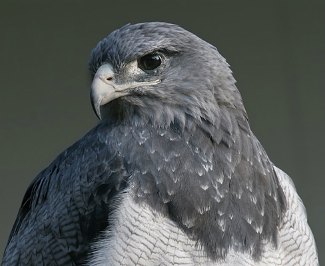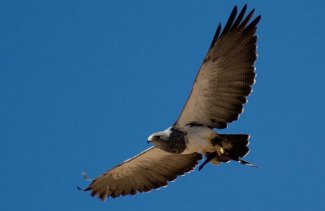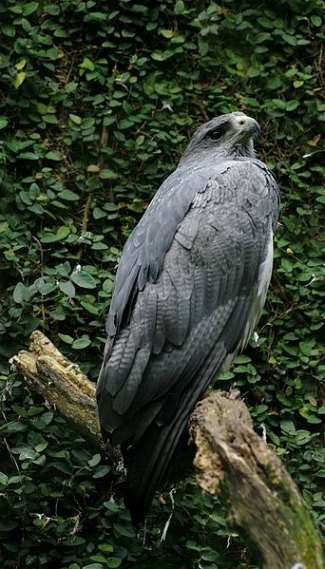Black-Chested Buzzard Eagle - Geranoaetus melanoleucus
By Stauss, GFDL, via Wikimedia Commons
Family: Accipitridae
Genus: Geranoaetus
Species: G. melanoleucus
Subspecies: G. m. australis, G. m. melanoleucus
Black-Chested Buzzard Eagles are large raptors that live along the the eastern and western sides of South America and at the tip of the continent. Despite their name, these birds are not true eagles and are called eagles based only on size.
Physical Description:
Black-Chested Buzzard Eagles are blue-gray in color with black and white markings. They have gray shoulders barred with black and a black to dark gray breast, while the belly and underparts are white and thinly barred. The wedge-shaped tail is black with a light gray terminal band. The wings are barred blue-gray and long and broad, a physical trait that is characteristic to the species. The head is gray to dark gray and the chin and throat are light gray. The feet, legs, and cere are yellow, and the eyes are brown.
Juveniles are dark brown to black, and the breast is heavily streaked. It takes 4-5 years for a juvenile to reach full adult plumage.
Black-Chested Buzzard Eagles eagles rarely call. When they do, it is usually while flying or in the vicinity of the nest. Listen to a recording.
Size:
Length: 62-80 cm
Wingspan: 175-200 cm
Weight: 1.7-3.2 kg
Habitat and Distribution:
Black-Chested Buzzard Eagles inhabit woodland, savannah, grassland, and desert. They are most common on steppes, mountain slopes, and rocky uplands, from 9°N to 56°S and live from 1,600-3,500 meters above sea level, although they have been found as high as 4,600 m.
Their range spans much of South America from Venezuela and Brazil down through the western side of the continent to the Tierra del Fuego. Their total distribution size is 6,810,000 km².
Diet and Hunting:
Their diet consists of small mammals such as degus (a type of rodent), rabbits, guinea pigs, foxes, and viscachas (another rodent, closely related to chinchillas), along with birds, some of which include Athene cunicularia (Burrowing Owl) and guans. Black-Chested Buzzard Eagles are also known to break into the mud nests of Furnarius rufus (Rufous Hornero—a type of ovenbird) to reach the nestlings inside. Snakes, lizards, insects, and carrion are also a part of their diet, as are skunks, which is the reason for their local name of “Stinky Bird”.
Hunting is done by foraging in flight and dropping to the ground to catch prey. They rarely hover and usually fly in circles or in long sweeps across an area.
By Guilherme Jofili, CC-BY-2.0, via Wikimedia Commons
Reproduction:
In the southern part of their range, the breeding season is February-April. It is September-April in the northern areas.
The nest is large, around 85 cm wide, and made out of sticks. It is built on a cliff ledge or in the fork of a tall tree, and Black-Chested Buzzard Eagles have also been known to nest on cacti. Nests are reused year after year and increase in size after each consecutive use. The clutch is 1-3 eggs, though the usual number is 2. The eggs are incubated for 30 days. Typically shy birds, they become very territorial of their nests. Even humans are known to have been attacked when getting too close.
Conservation:
Black-Chested Buzzard Eagles have been listed as Least Concern by BirdLife International. They have a large range and a stable population trend, although there is a reported decline in Argentina due to poisons used by ranchers.
Taxonomy:
Black-Chested Buzzard Eagles are closely related to the Buteo buzzard family, and are called eagles based on their size, not their taxonomic relationship.
Geranos means "crane", referring to the color of the wing, and aetos means "eagle" in Greek. Melanos means "black" and leukos "white", referring to the colors of the belly and underparts.
Subspecies:
There are two subspecies: G. m. australis, which lives in northwest Venezuela and western South America to the Tierra del Fuego, and G. m. melanoleucus, which lives southern and eastern Brazil, Paraguay, eastern Argentina, and Uruguay. G. m. australis is smaller and always has barred white underparts, while its larger counterpart does not.
Other Names:
Chilean Blue Eagle, Gray Eagle-Buzzard, Andesvåge (Danish), Grijze arendbuizard (Dutch), Kotkasviu (Estonian), Marsuhaukka (Finnish), Buse aguia (French), Agula (German), Poiana-aquila pettonero (Italian), Haiirooonosuri (Japanese), Hødingvåk (Norwegian), Águia-chilena (Portuguese), Águia mora, Águia real (Spanish), Svartbröstad vråkörn (Swedish).
Video of Black-Chested Buzzard Eagles:
References:
http://avibase.bsc-eoc.org/species.jsp?avibaseid=51405606DCBA4A00
BirdLife International (2011) Species factsheet: Geranoaetus melanoleucus. Downloaded from
http://www.birdlife.org on 26/08/2011.
BirdLife International 2009. Geranoaetus melanoleucus. In: IUCN 2011. IUCN Red List of Threatened Species. Version 2011.1.
www.iucnredlist.org. Downloaded on 26 August 2011.
http://ibc.lynxeds.com/species/black-chested-buzzard-eagle-geranoaetus-melanoleucus
http://www.raptorfoundation.org.uk/bcbeagle.html
Ferguson-Lees, James, and Christie, David A. Raptors of the World. Houghton Mifflin Company, 2001.


